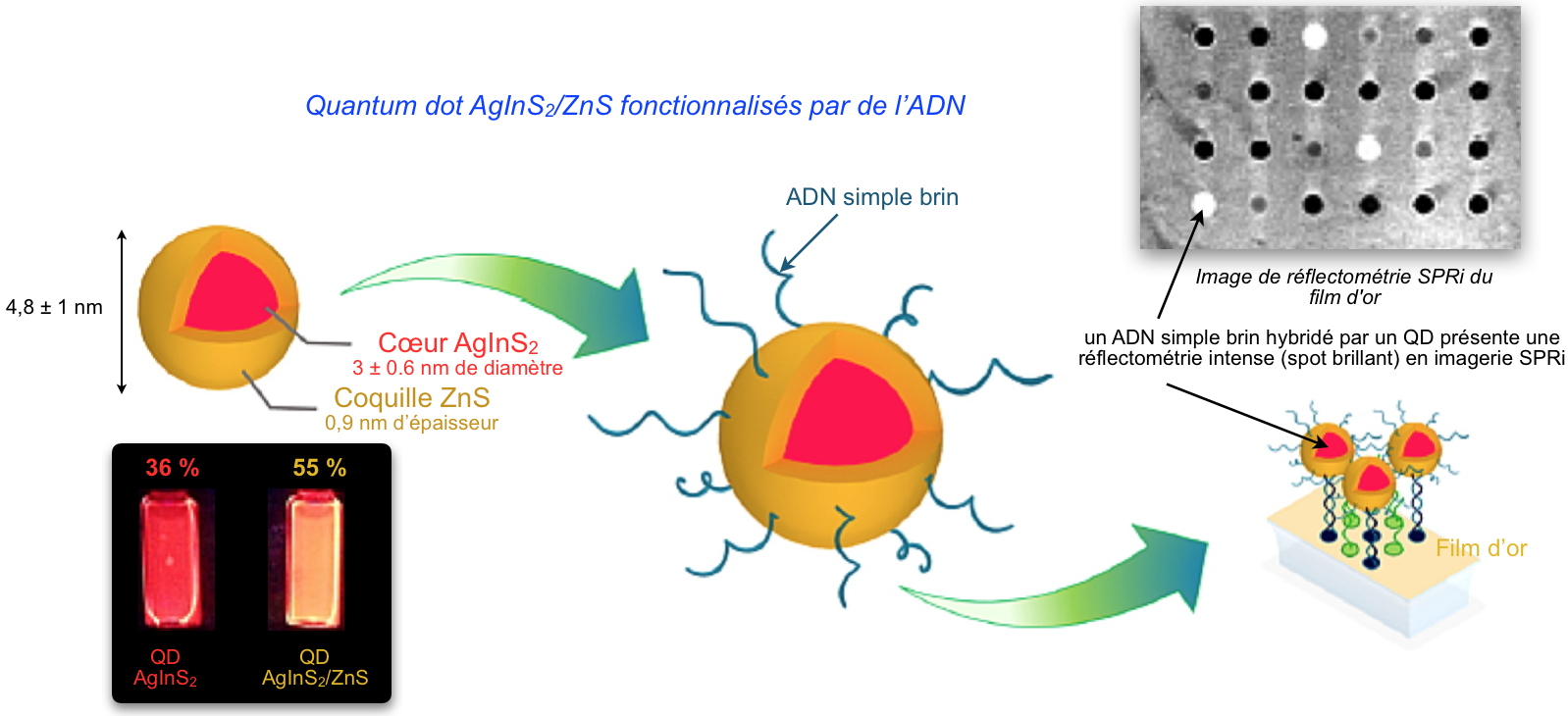Fluorescent emitters are of great interest for biomedical applications. With appropriate functionalization, they can be used to detect or label biomolecules in order to follow
in vivo their evolution in complex biological environments (cells, organisms). Among the large variety of luminescent probes, semiconductor quantum dots (QDs) have the advantages of being stable and much more resistant to optical (or laser) excitation than organic fluorophores. Besides, depending on their sizes and chemical compositions, they are able to emit light over a broad spectral range, from visible to infrared. QDs have thus an important advantage for multicolor and long duration imaging. Emission in the near infrared is particularly interesting because the absorption and scattering of light by the biological environment are strongly reduced. But, are these QDs biocompatible?
The classical QDs emitting in the near infrared range present often cytotoxicity caused by the presence of metals such as cadmium or lead. This is why great efforts are currently made for the development of biocompatible QDs, without the use of toxic heavy metals. Among the environment-friendly QDs, those based on silver and indium, AgInS
2, are particularly promising thanks to their high photoluminescence quantum yield (
PLQY); PLQYs up to 66% have been reported in the literature. To make them compatible with biomedical applications, it is necessary to make appropriate functionalization on the surface of these QDs, while limiting the decrease of the photoluminescence quantum yield related to such a modification.
The complementary expertise of three teams at our institute (
see box) has made it possible to develop a new method for the synthesis of AgInS
2 QDs. Such QDs were then covered with a ZnS shell and functionalized by single-strand DNAs (
Figure), while preserving their high luminescence (final PLQY of 42% with infrared emission at 650-750 nm). In practice, the colloidal synthesis was carried out in aqueous medium allowing to obtain directly water-soluble QDs. The single-strand DNAs were incorporated during the growth of the ZnS shell around the AgInS
2 QD, forming QD-DNA complexes. The success of DNA anchoring on QDs was demonstrated by several techniques (UV-visible spectroscopy, gel electrophoresis, dynamic light scattering, and zeta potential). Furthermore, surface plasmon resonance imaging (SPRi) on a DNA chip (composed of complementary DNA spots and negative control DNA spots deposited on a gold film), has shown that the QD-DNAs are exclusively bound onto the spots of complementary DNA
via hybridization (
Figure). This further demonstrates the success and the stability of the QD-DNA coupling and the preservation of the biological activity of the anchored DNA.
The non-toxicity, long-term stability and biocompatibility of these QD-DNAs open important perspectives. In addition to potential applications as fluorescent probes for live cell imaging or as building blocks for nanosensors, they can also be coupled to other functional blocks in which DNA serves as smart linker: FRET nanoprobes involving energy transfer between fluorescent molecules or plasmonic nano-antennas for bio-imaging and biodetection.

Quantum dot AgInS
2/ZnS functionalized with DNA.
QDs consisting of an AgInS
2 core (PLQY = 36%) and a ZnS shell (PLQY = 55%) are functionalized with single-stranded DNA molecules (final PLQY of 42%). SPRi showed that the DNA-QDs are selectively bound onto the spots functionalized with their complementary DNA strands
via hybridization, giving an intense reflectivity signal.
AgInS2 : silver indium sulfide, ternary compound I-III-VI of chalcopyrite type.
PLQY: PhotoLuminescence Quantum Yield is the ratio of the number of photons emitted to the number of photons absorbed.
This landmark result was achieved in the DRF-Impulse funded HybriDimer project (2018-2020), which recruited Annette Delices as a postdoc. The project aims to design, realize and characterize mixed nano-architectures composed of a semiconductor nanocrystal (Quantum Dot or QD) connected to a gold nano-rod (GNR, Gold NanoRod) by DNA strands. This hybrid structure allows to control the light emission properties of the QD (diameter ~ 5 nm) by plasmonic coupling, by adjusting the length of the DNA strands.
This project brings together a large multidisciplinary consortium within our institute: specialists in condensed matter physics and nanostructures for electromagnetic simulations and optics (NPSC team of the
Pheliqs laboratory), colloidal synthesis of QDs (STEP team within our laboratory), surface chemistry for regio-selective functionalization of GNRs (CREAB team within our laboratory), biochemistry for DNA synthesis and purification (CREAB), nanocharacterization of biological and biohybrid structures (
IBS and
MEM laboratory).
The project continues with the thesis of Nicolas Daveau (2020-2023) funded jointly by the labex ARCANE and LANEF.